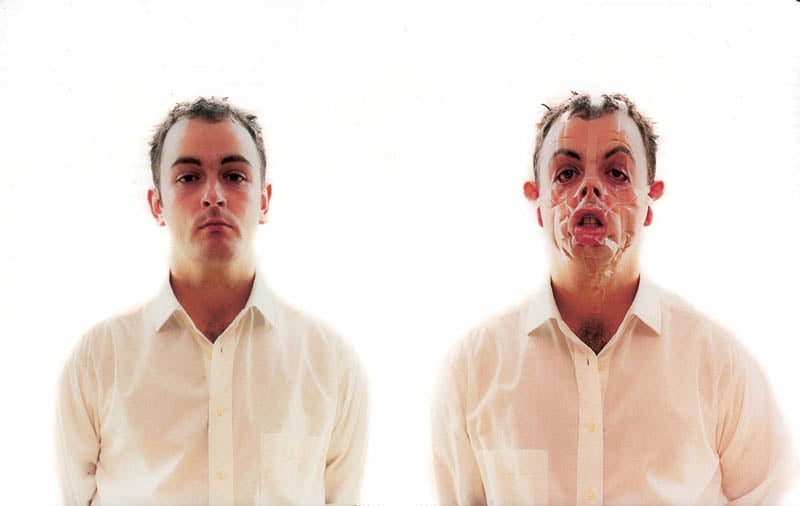
© » KADIST
Michael Landy
H.2. N. Y Skeleton of the Dump revolves entirely around the performance “Homage to New York” (1960), of the Swiss artist Jean Tinguely (1925-1991), during which the machine built by the artist in the gardens of the Museum of Modern Art (MOMA) had to self-destruct itself in 27 minutes, but, in the end, it had to be finished off by firemenbeing called in after it erupted in flames. Since the discovery of Jean tinguely’s retrospective at the Tate Gallery in London, in 1982, Michael Landy spent two years researching and sketching (charcoal, oil, glue, ink) from his previous research carried out at Museum Tinguely in Basel, and at the MOMA in New York.

© » KADIST
Douglas Gordon
Blind Spencer is part of the series “Blind Stars” including hundreds of works in which the artist cut out the eyes of Hollywood stars, in a symbolically violent manner. An emptiness (some are burned letting appear a white or mirror background or a mirror) replaces the eyes, giving the impression of a blind eye deprived of all expression. Paradoxically, the work looks at us all the more intensely.

© » KADIST
Tacita Dean
The photographic quality of the film Baobab is not only the result of a highly sophisticated use of black and white and light, but also of the way in which each tree is characterized as an individual, creating in the end a series of portraits. The monumental and unnatural aspect of the baobabs turns them into strange and anthropomorphic personalities. Adding to the descriptive aspect of the film, the sound is a recording of the environment, of sounds made by animals, and participates in this peaceful contemplation.

© » KADIST
Douglas Gordon
Douglas Gordon’s single-channel video The Left Hand Can’t See That The Right Hand is Blind, captures an unfolding scene between two hands in leather gloves—at first seemingly comfortable to be entwined, and later, engaged in a struggle. As suggested by the work’s title, each of the hands assumes a character with a distinct personality, as if we were witnessing a lovers’ quarrel and embrace, or the embodiment of opposing forces of an internal struggle. Gordon has previously created performance-based works depicting his own body or parts of it—arms, hands, fingers, eyes—usually enacting simple, repetitive movements.

© » KADIST
Douglas Gordon
In Monster (1996-97), the artist’s face becomes grotesque through the application of strips of transparent adhesive tape, typical of Gordon’s performance-based films that often depict his own body in action. Also characteristic of his work, the scene takes place in front of a mirror, suggesting the kind of personal self-reflection that one is capable of – both good and evil. The video makes clear cinematographic reference to the ‘alter-ego’ transformation in Mamoulian’s Dr. Jekyll and Mr. Hyde, and to the “You looking at me?” sequence performed in front of a mirror by Robert De Niro in Scorsese’s Taxi Driver which also inspired Gordon’s through a looking glass ( 1999).
Douglas Gordon
- location: Berlin, Germany
- year born: 1966
- gender: male
- nationality: Scottish
- home town: Glasgow, United Kingdom
Michael Craig-Martin
Michael Craig-Martin studied fine art at Yale University returning to Europe in the mid-1960s and becoming one of the key figures in the first generation of British conceptual artists...
Michael Landy
- location: London, United Kingdom
- year born: 1963
- gender: male
- nationality: British
Chris Ofili
- location: Manchester, United Kingdom
- year born: 1968
- gender: male
- nationality: British
Tacita Dean
- location: Berlin, Germany
- year born: 1965
- gender: female
- nationality: British
- home town: Canterbury, United Kingdom
-
1990-1999
Douglas Gordon
1996In Monster (1996-97), the artist’s face becomes grotesque through the application of strips of transparent adhesive tape, typical of Gordon’s performance-based films that often depict his own body in action...
-
2000-2009
Tacita Dean
2001The photographic quality of the film Baobab is not only the result of a highly sophisticated use of black and white and light, but also of the way in which each tree is characterized as an individual, creating in the end a series of portraits...
Douglas Gordon
2002Blind Spencer is part of the series “Blind Stars” including hundreds of works in which the artist cut out the eyes of Hollywood stars, in a symbolically violent manner...
Douglas Gordon
2004Douglas Gordon’s single-channel video The Left Hand Can’t See That The Right Hand is Blind, captures an unfolding scene between two hands in leather gloves—at first seemingly comfortable to be entwined, and later, engaged in a struggle...

